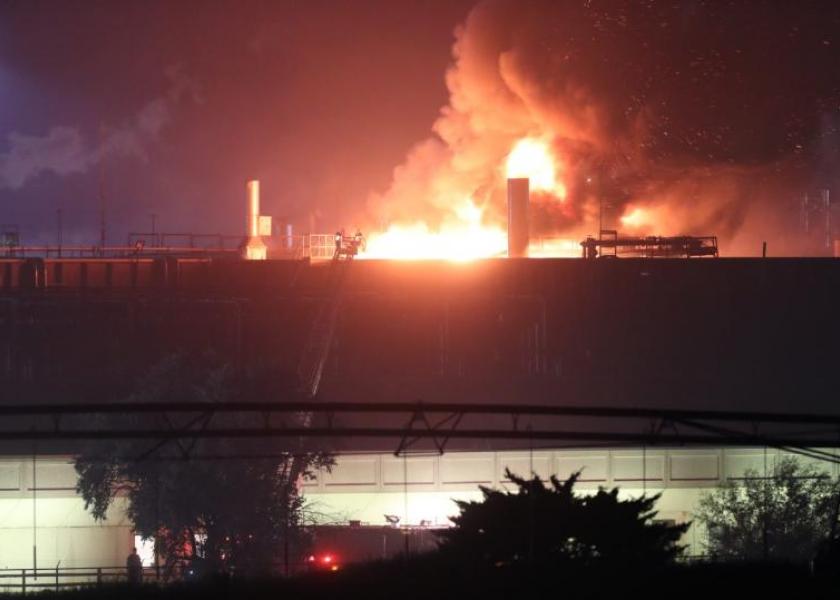Industry Proves Capable Of Scrambling

Last month’s fire at Tyson’s Finney County, Kan., harvest facility shuttered the plant indefinitely and sent the industry in a tailspin.
The fire, on Aug. 9, took 6% of the industry’s slaughter capacity offline at a time when beef packers were already running at 91% of capacity. The timing also meant the industry had a full weekend to consider the ramifications.
The fallout proved devastating to cattlemen as CME Live Cattle and Feeder futures markets locked limit down on Monday following the fire, and for the week Live Cattle lost $8.70, and Feeder futures lost more than $5. Cash cattle sold at least $6 per cwt lower the week following the fire.
Despite the market uncertainty, packers proved their ability to scramble when necessary. USDA reported slaughter numbers the week ending Aug. 16 at 651,000 head, or 9,000 more than the previous week when the Finney County plant was still in operation. The early aftermath confirmed two truisms — the market overcorrected to the down side, and the industry is capable of scrambling to keep weekly slaughter moving and beef flowing to retailers and consumers.
“Saturday slaughter totals are up, and that’s an example of the industry adjusting and adapting,” Kansas State University economist Glynn Tonsor said two weeks after the fire. “That’s not to say it’s free or that it’s easy.”
Immediately following the fire, Tyson Foods executives sought to reassure both the beef industry and its employees. Steve Stouffer, group president of Tyson Fresh Meats, said plant repairs would begin immediately and the 3,800 employees affected by the plant’s closure would be paid until it reopens.
Stouffer says the company is “taking steps to move production to alternative sites. Tyson Foods has built in some redundancy to handle situations like these, and we will use other plants within our network to help keep our supply chain full.”
Tonsor says the entire industry was already adjusting, with many plants and even some cow slaughter plants picking up the slack.
Further, he says, seasonality played a role in how the packing industry was able to respond.
“Over the last 20 years, we see an increase in slaughter of about 5,500 head in 14 of those years for that particular week in August,” Tonsor says. “There’s a seasonal tendency to have more cattle coming to market, and that ball was in motion before the Tyson fire. I think we would have seen an increase of more than the 9,000 recorded if not for the fire.”
Much of the market’s uncertainty, however, revolves around the number of cattle on feed, and if the packing industry can continue at its current pace. In an August National Cattlemen’s Beef Association (NCBA) conference call, industry analysts acknowledged the progress made in moving and processing cattle, but noted challenges remain.
Chief among those challenges is the nearly 1 million additional cattle on feed this year compared with 2018, and a disproportionate number of those additional cattle are in the Kansas area near the fire-damaged Tyson plant.
CattleFax vice president of industry relations and analysis Kevin Good says packers are increasing their slaughter with Saturday shifts, and notes one recent Saturday saw 64,000 cattle harvested. He also says plants that typically slaughter fed cattle and cows have shifted to processing more fed cattle.
Good says packers will continue to have a challenge to keep up and he would not rule out the possible addition of Sunday shifts. He also predicted more cattle moving from the central and northern Plains to two areas that currently have excess shackle space — the Pacific Northwest and Alberta, Canada.
NCBA was also working with federal agencies that might help as the industry adjusts to the new reality. Colin Woodall, senior vice president for government affairs, says NCBA had been in contact with USDA’s Food Safety and inspection Service and Agricultural Marketing Service to get inspectors and graders moved to the plants that need them to keep longer hours and Saturday shifts moving.
NCBA also reported it was seeking a waiver of both hours of service and highway weight restrictions from the Department of Transportation to help move cattle from Kansas to other states for slaughter, though DOT has not agreed to a waiver.
While running at 95% of capacity or more will be a challenge for packers, there is plenty of financial incentive to do so. Boxed beef values skyrocketed in the two weeks following the fire, with Choice climbing nearly $24 per cwt. Coupled with the $5 decline in fed cattle prices, packer margins climbed to nearly $500 per head, a historically high value.
“That’s a bitter pill for many cattle feeders to swallow,” says John Nalivka, president of Sterling Marketing, Vale, Ore. “But the industry is fortunate that packers were in a period of profitability when the Tyson fire occurred. Otherwise the incentive to rebuild and pick up the slack in other regions wouldn’t have been strong.”
Another silver lining was the fact that feedyards were very current in their marketings.
“Slaughter was up two weeks following the fire,” Tonsor says. “Cold storage numbers were tight. Those facts point to the idea beef is not stacking up, and somebody’s pulling it forward. On balance, those facts generally point to a stronger cash market.”
Nalivka also sees stronger cash prices as a possibility for the fall, and the Tyson fire has not tempered that optimism.
For its part, Tyson says it is committed to repairing its Finney County facility as soon as possible, but Stouffer says the fire caused major damage, and “it will be a matter of months, not weeks, but no specific timeline at this point.”
Tyson officials say the square footage of the damaged area was small compared to the entire plant, but the fire affected critical operating systems. Tyson says structural work began immediately, but other repairs, particularly electrical, will likely take more time.
Related stories:







